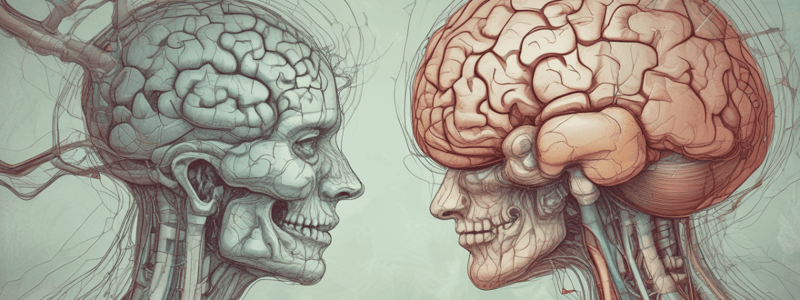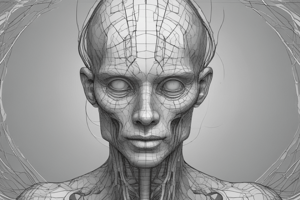Podcast
Questions and Answers
What percentage of the corticospinal tract originates from the somatic sensory areas?
What percentage of the corticospinal tract originates from the somatic sensory areas?
- 20%
- 40% (correct)
- 30%
- 50%
What is the transmission rate of the large fibers arising from the giant pyramidal cells (Betz cells)?
What is the transmission rate of the large fibers arising from the giant pyramidal cells (Betz cells)?
- 20m/sec
- 100m/sec
- 70m/sec (correct)
- 40m/sec
What is the function of the small diameter fibers that make up 97% of the total number of fibers in the corticospinal tract?
What is the function of the small diameter fibers that make up 97% of the total number of fibers in the corticospinal tract?
- Conduct fast transmission signals
- Provide feedback signals to the brain
- Conduct background tonic signals (correct)
- Regulate the intensity of sensory signals
What is the destination of the fibers from the red nucleus in the corticospinal tract?
What is the destination of the fibers from the red nucleus in the corticospinal tract?
What is the function of the Betz collaterals?
What is the function of the Betz collaterals?
What is the primary function of the premotor area?
What is the primary function of the premotor area?
Damage to which area of the motor cortex can cause motor apraxia?
Damage to which area of the motor cortex can cause motor apraxia?
What is the primary difference between the direct and indirect pathways of cortical motor signals?
What is the primary difference between the direct and indirect pathways of cortical motor signals?
What is the characteristic of the topographic representation in the primary motor cortex?
What is the characteristic of the topographic representation in the primary motor cortex?
What is the function of the supplemental motor area?
What is the function of the supplemental motor area?
Which of the following nuclei of the thalamus is involved in the coordination of function between motor cortex, basal ganglia, and cerebellum?
Which of the following nuclei of the thalamus is involved in the coordination of function between motor cortex, basal ganglia, and cerebellum?
What type of fibers are transmitted from the magnocellular portion of the red nucleus to form the rubrospinal tract?
What type of fibers are transmitted from the magnocellular portion of the red nucleus to form the rubrospinal tract?
What is the result of stimulating the red nucleus?
What is the result of stimulating the red nucleus?
Which of the following is NOT a source of incoming sensory pathways to the motor cortex?
Which of the following is NOT a source of incoming sensory pathways to the motor cortex?
What is the organization of the magnocellular portion of the red nucleus?
What is the organization of the magnocellular portion of the red nucleus?
What is the primary function of the semicircular ducts in maintaining equilibrium?
What is the primary function of the semicircular ducts in maintaining equilibrium?
What happens to the endolymph in the semicircular duct when the duct rotates?
What happens to the endolymph in the semicircular duct when the duct rotates?
What is the primary function of the predictive function of the semicircular ducts?
What is the primary function of the predictive function of the semicircular ducts?
What is the role of the crista ampullaris in the semicircular duct?
What is the role of the crista ampullaris in the semicircular duct?
What is the relationship between the semicircular ducts and equilibrium?
What is the relationship between the semicircular ducts and equilibrium?
What is the primary function of sensory feedback from muscle spindle, tactile receptors, and proprioceptors in motor control?
What is the primary function of sensory feedback from muscle spindle, tactile receptors, and proprioceptors in motor control?
Which type of neurons in the spinal cord are directly synapsed by some corticospinal and rubrospinal neurons?
Which type of neurons in the spinal cord are directly synapsed by some corticospinal and rubrospinal neurons?
What is the result of a lesion in the basal ganglia?
What is the result of a lesion in the basal ganglia?
What is the primary function of the brainstem in motor control?
What is the primary function of the brainstem in motor control?
Which brainstem nuclei excite the antigravity muscles?
Which brainstem nuclei excite the antigravity muscles?
Flashcards are hidden until you start studying
Study Notes
Motor Cortex
- Divided into 3 sub-areas: primary motor cortex, premotor area, and supplemental motor area
- Primary motor cortex:
- Unequal topographic representation
- Elicits fine motor movement with stimulation
- Premotor area:
- Topographical organization similar to primary motor cortex
- Stimulation results in movement of muscle groups to perform specific tasks
- Works in concert with other motor areas
- Supplemental motor area:
- Topographically organized
- Stimulation often elicits bilateral movements
- Functions in concert with premotor area to provide attitudinal, fixation, or positional movement for the body
Specialized Areas of the Motor Cortex
- Broca's area:
- Damage causes decreased speech capability
- Closely associated area controls appropriate respiratory function for speech
- Eye fixation and head rotation area:
- Coordinates head and eye movements
- Hand skills area:
- Damage causes motor apraxia (inability to perform fine hand movements)
Transmission of Cortical Motor Signals
- Direct pathway:
- Corticospinal tract
- For discrete detailed movement
- Indirect pathway:
- Signals to basal ganglia, cerebellum, and brain stem nuclei
The Corticospinal Tract
- Originates in primary motor cortex (30%), supplementary motor areas (30%), and somatic sensory areas (40%)
- Majority of fibers cross to opposite side in medulla and descend in lateral corticospinal tracts
- Corticospinal fibers synapse with interneurons, anterior motor neurons, and a few sensory relay neurons in the cord gray matter
- Giant pyramidal cells (Betz cells) give rise to large fibers with fast transmission rates (70m/sec)
Corticospinal Fibers
- 34,000 Betz cell fibers make up only about 3% of the total number of fibers
- 97% of the 1 million fibers are small-diameter fibers that conduct background tonic signals and feedback signals from the cortex to control intensity of sensory signals to the brain
Other Pathways from the Motor Cortex
- Betz collaterals back to cortex sharpen the boundaries of the excitatory signal
- Fibers to caudate nucleus and putamen
- Fibers to the red nucleus, which then sends axons to the cord in the rubrospinal tract
- Fibers to reticular substance, vestibular nuclei, and pons, then to the cerebellum
- Therefore, the basal ganglia, brain stem, and cerebellum receive a large number of signals from the cortex
Incoming Sensory Pathways to Motor Cortex
- Subcortical fibers from adjacent areas of the cortex, especially from somatic sensory areas of parietal cortex and visual and auditory cortex
- Subcortical fibers from opposite hemisphere, which pass through corpus callosum
- Somatic sensory fibers from ventrobasal complex of the thalamus (i.e., cutaneous and proprioceptive fibers)
Red Nucleus and the Rubrospinal Tract
- Substantial input from primary motor cortex
- Primary motor cortex fibers synapse in the lower portion of the nucleus (magnocellular portion), which contains large neurons similar to Betz cells
- Magnocellular portion gives rise to rubrospinal tract
- Magnocellular portion has somatotopic organization similar to primary motor cortex
Sensory Feedback is Important for Motor Control
- Feedback from muscle spindle, tactile receptors, and proprioceptors fine-tunes muscle movement
- Length mismatch in spindle causes auto-correction
- Compression of skin provides sensory feedback to motor cortex on degree of effectiveness of intended action
Excitation of Spinal Motor Neurons
- Motor neurons in cortex reside in layer V
- Excitation of 50-100 giant pyramidal cells is needed to cause muscle contraction
- Most corticospinal fibers synapse with interneurons
- Some corticospinal and rubrospinal neurons synapse directly with alpha motor neurons in the spinal cord, especially in the cervical enlargement
- These motor neurons innervate muscles of the fingers and hand
Control of Motor Function by the Brainstem
- Brainstem as an extension of the spinal cord
- Performs motor and sensory functions for the face and head (i.e., cranial nerves)
- Similar to spinal cord for functions from the head down
- Contains centers for stereotypic movement and equilibrium
Support of the Body Against Gravity
- Muscles of the spinal column and the extensor muscles of the legs support the body against gravity
- These muscles are under the influence of brainstem nuclei
- Pontine reticular nuclei excite the antigravity muscles
- Medullary reticular nuclei inhibit the antigravity muscles
Studying That Suits You
Use AI to generate personalized quizzes and flashcards to suit your learning preferences.




